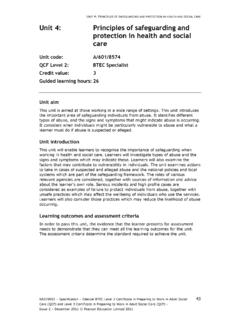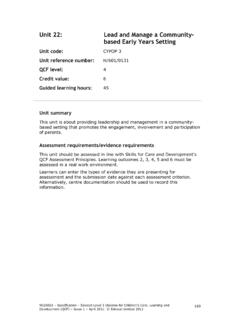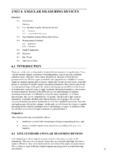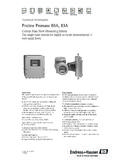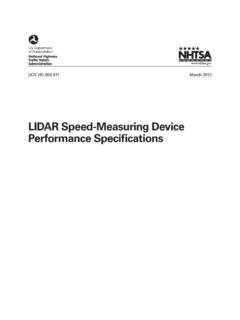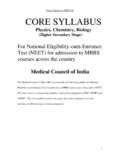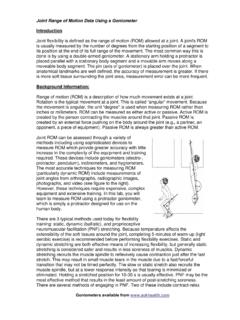Transcription of Unit 065 General machining, fitting and assembly …
1 473 unit 065 General machining , fitting and assembly applications Level: 2 Credit value: 12 NDAQ number: 500/9514/6 unit aim This unit covers the skills and knowledge needed to prove the competences required to cover a broad range of basic machining , fitting and assembly activities that will prepare the learner for entry into the engineering or manufacturing sectors, creating a progression between education and employment, or that will provide a basis for the development of additional skills and occupational competences in the working environment. The learner will be expected to carry out practical exercises in order to gain an understanding of how these machining , fitting and assembly activities are undertaken, the types of equipment used, the manufacturing techniques, and the operating and safety procedures that are required. In carrying out the activities, the learner will use appropriate tools and equipment to mark out the material for the features to be produced, and then to use hand tools, portable power tools, machine tools and shaping, fitting and assembly techniques appropriate to the operations being performed.
2 These activities will include such things as hand sawing, filing, drilling, turning, milling and assembly . During, and on completion of, the operations, the learner will be expected to check the quality of the workpiece, using measuring equipment appropriate to the aspects being checked and the tolerances to be achieved. The learner will need to be able to recognise when the activities are not meeting the required specification, and to discuss/determine what action needs to be taken to remedy any faults that occur, in order to ensure that the finished workpiece is within the specification requirements. On completion of the activities, the learner will be expected to return all tools and equipment that they have used to the correct location, and to leave the work area in a safe and tidy condition. The learner s responsibilities will require them to comply with health and safety requirements and organisational policy and procedures for the activities undertaken. The learner will need to take account of any potential difficulties or problems that may arise with the activities, and to seek appropriate help and advice in determining and implementing a suitable solution.
3 The learner will work under a high level of supervision, whilst taking responsibility for their own actions and for the quality and accuracy of the work that they carry out. The learner s knowledge will provide an understanding of their work, and will enable them to apply appropriate machining , fitting and assembly techniques and procedures safely. The learner will understand the machining , fitting and assembly processes, and their application, and will know about the equipment, materials and consumables, to the required depth to provide a sound basis for carrying out the activities to the required specification. The learner will understand the safety precautions required when carrying out the various machining , fitting and assembly techniques, and when using hand tools and machinery. The learner will be required to demonstrate safe working practices throughout, and will understand the responsibility they owe to themselves and others in the workplace. 474 Learning outcomes There are two learning outcomes to this unit .
4 The learner will be able to: 1. Carry out General machining , fitting and assembly applications 2. Know how to carry out General machining , fitting and assembly applications Guided learning hours It is recommended that 55 hours should be allocated for this unit , although patterns of delivery are likely to vary. Details of the relationship between the unit and relevant national standards This unit has been derived from national occupational standard Performing Engineering Operations unit No. 65: General machining , fitting and assembly applications (Suite 2). Support of the unit by a sector or other appropriate body This unit is endorsed by Semta. Assessment This unit must be assessed in a work environment and must be assessed in accordance with the Common Requirements for National Vocational Qualifications (NVQ) in the QCF which can be downloaded from Semta s website: Additional assessment requirements have been published by Semta. These additional assessment requirements are set down in Semta s Performing Engineering Operations Level 2 unit assessment strategy which can be downloaded from Semta s website: 475 unit 065 General machining , fitting and assembly applications Outcome 1 Carry out General machining , fitting and assembly applications Assessment criteria Practical skills The learner will be able to: 1.
5 Work safely at all times, complying with health and safety legislation, regulations and other relevant guidelines 2. carry out all of the following during the machining , fitting and assembly activities: adhere to procedures or systems in place for risk assessment, COSHH, personal protective equipment and other relevant safety regulations ensure that all hand tools and equipment used are in a safe and serviceable condition (such as cables to hand tools and extension leads, file handles, hammer striking faces) ensure that all machine tools are correctly guarded at all times check that all measuring equipment is within calibration date return all tools and equipment to the correct location on completion of the fitting activities 3. determine what has to be done and how they are going to do it 4. obtain the appropriate tools and equipment for the manufacturing operations 5. mark out the components for the required operations, using appropriate tools and techniques to include all of the following: preparing/determining suitable datums from which to mark out (such as choosing a machine face or filing a flat face as a datum) applying a marking medium to enhance clarity of the marking out using an appropriate method of marking out (such as direct marking using instruments, use of templates or tracing/transfer methods) using a range of marking out equipment (such as rules, squares, scribers, Vernier instruments) marking out a range of features (such as datum/centre lines, square/rectangular profiles, circles/radial profiles, hole positions) 6.
6 Cut and shape the materials to the required specification, using appropriate tools and techniques 7. cut and shape two different types of material from the following: low carbon/mild steel high carbon steel cast iron stainless steel aluminium/aluminium alloys brass/brass alloys plastic/nylon/synthetic composite other specific material 476 8. Use appropriate methods and techniques to assemble and secure the components in their correct positions 9. use three of the following workholding devices: bench vice machine vice clamps (such as toolmaker s) three-jaw chuck four-jaw chuck collet chuck drive plate and centres 10. use a range of hand fitting methods, to include all of the following: cutting out the rough profile using saws (such as hacksaw, band saw) cutting a screw thread (such as by tapping or dieing) filing flat and square filing a curved profile drilling holes 11. produce mechanical assemblies, using six of the following methods and techniques: assembling components having interference fits (such as by pressure, expansion or contraction) securing components using threaded fasteners (such as nuts, bolts, machine screws, cap screws) securing components using spring clips (such as external circlips, internal circlips, special clips) using locking and retaining devices (such as tab washers, locking nuts, wire locks, special purpose types) securing components using rivets (such as countersunk, roundhead, blind, special purpose types) applying sealing compounds or adhesives electrical bonding of components setting and adjusting components to give correct working parameters (such as shimming and packing) torque setting of nuts and bolts 12.
7 Carry out turning operations to include all of the following: mounting the workpiece in an appropriate workholding device mounting cutting tools in tool holders to give the correct centre height selecting and setting appropriate feeds and speeds facing off producing parallel diameters producing stepped diameters producing tapered diameters centre drilling and drilling a hole reaming or boring a hole 13. carry out milling operations, to include all of the following: mounting the workpiece in an appropriate workholding device mounting cutting tools on appropriate arbors or direct to the machine spindle selecting and setting appropriate feeds and speeds 477 producing flat and square faces producing parallel faces producing angular faces producing an enclosed slot producing an open ended slot 14. measure and check that all dimensional and geometrical aspects of the component are to the specification 15. carry out the necessary checks for accuracy, to include all of the following: linear dimensions (such as lengths, depths) diameters (such as external, internal) flatness squareness angles profiles hole size and position thread size and fit surface finish 16.
8 Use the following measuring equipment during the checking activities: external micrometers Vernier/digital/dial calliper surface finish equipment (such as comparison plates, machines) Plus four more of the following: rules squares protractors depth micrometers depth Verniers feeler gauges bore/hole gauges slip gauges radius/profile gauges thread gauges dial test indicators (DTI) 17. produce components within all of the following standards, as applicable to the process: components to be free from false tool cuts, burrs and sharp edges dimensional tolerance +/- or +/- flatness and squareness per 25mm or per inch angles within +/- 1 degree screw threads to BS Medium fit reamed holes within H8 surface finish 63 in or m 18. deal promptly and effectively with problems within their control, and seek help and guidance from the relevant people if they have problems that they cannot resolve 19. leave the work area in a safe and tidy condition on completion of the manufacturing activities 478 unit 065 General machining , fitting and assembly applications Outcome 2 Know how to carry out General machining , fitting and assembly applications Assessment criteria Underpinning knowledge The learner will be able to: 1.
9 Describe the health and safety requirements, and safe working practices and procedures required for the machining , fitting and assembly activities undertaken (such as wearing appropriate protective clothing and equipment, using machine guards, and of keeping the work area safe and tidy 2. describe the hazards associated with the activities (such as use of power tools, trailing leads or hoses, damaged or badly maintained tools and equipment, using files with damaged or poor fitting handles, using machine tools), and how they can be minimised 3. explain how to extract and use information from engineering drawings and related specifications (to include symbols and conventions to appropriate BS or ISO standards) in relation to work undertaken 4. explain how to interpret first and third angle drawings, imperial and metric systems of measurement, workpiece reference points and system of tolerancing 5. explain how to prepare the materials in readiness for the marking out activities, in order to enhance clarity, accuracy and safety (such as visually checking for defects, cleaning the materials, removing burrs and sharp edges, applying a marking-out medium) 6.)
10 Explain how to select and establish a suitable datum; the importance of ensuring that marking out is undertaken from the selected datum, and the possible effects of working from a different datum 7. describe the use of marking-out conventions when marking out the workpiece (such as datum lines, cutting guidelines, square and rectangular profiles, circular and radial profiles, angles, holes linearly positioned, boxed and on pitch circles) 8. describe the various fitting activities to be carried out (such as how to file flat, square and curved surfaces and achieve a smooth surface finish; how to select saw blades for different materials, and how to set the saw blades for different operations; how to produce screw threads on workpieces using hand dies; how to determine the drill size for tapped holes, and the importance of using the taps in the correct sequence) 9. explain how to prepare drilling machines for operations (such as adjustment of table height and position; mounting and securing drills, in chucks or Morse taper sockets; setting and adjusting spindle speeds; setting and adjusting guards/safety devices) 10.
